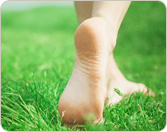Foot

Bunions
A bunion is a bony protuberance that appears on the external surface of the big toe when it angles toward the adjacent toe. It is an extra bone and a fluid-filled sac that grows at the base of the big toe.
For more information about Bunions, click on below tab.
Heel Pain
The heel is made up of the calcaneus bone and supported by a network of muscles, tendons, ligaments and soft tissues, which together support the weight of the body and stress during movement. Heel pain is a common symptom of excessive strain placed on these structures.
For more information about Heel Pain, click on below tab.
Ingrown Toenail
An ingrown toenail is a common and painful condition of the toe. It occurs when the sides or corner of the nail grow inwards and penetrates into the skin of the toe. Pain is often accompanied by swelling and redness. The big toe is affected most often.
For more information about Ingrown Toenail, click on below tab.
Corns and Calluses
A corn is a circular area of thickened skin developed as a result of continuous friction or pressure. They usually develop on the soles of feet, or on the top or sides of toes, and appear as yellowish dead tissue surrounding an area of tenderness. Pain and discomfort may be present with walking, which can get more painful without treatment.
For more information about Corns and Calluses, click on below tab.
Plantar Fasciitis
The plantar fascia is a long, thin ligament present along the bottom of the foot that creates the arch of the foot. It extends from the heel bone, and then splits and fans out to attach itself to the toes.
For more information about Plantar Fasciitis, click on below tabs.
FLATFOOT
Flatfoot, also known as “fallen arches” or Pes planus, is a deformity in children’s feet in which the arch that runs lengthwise along the sole of the foot has collapsed to the ground or not formed at all. Flatfoot is normal in the first few years of life as the arch of the foot usually develops between the age of 3 and 5 years. Flatfoot can be rigid or flexible. Flexible flatfoot usually resolves without any treatment needed unless pain is involved. Rigid pediatric flatfoot however can cause joint pain in the leg when walking or an aching pain in the feet and usually requires intervention.
For more information about FLATFOOT, click on below tab.
Hammertoe
A hammertoe is a deformity of a lesser toe (second through fifth toes), where the toe gets bent upward at the toe’s middle joint, resembling a hammer. The bent portion may rub against a shoe causing pain, irritation and development of corns. It is caused by wearing shoes that are too tight or narrow near the toes, when the second toe is larger than the first, and as a complication of arthritis and certain neuromuscular conditions.
For more information about Hammertoe, click on below tab.
Morton’s Neuroma
Morton’s neuroma refers to a nerve injury between the toes, usually the third and fourth toes, which causes pain and thickening of the nerve tissue. Compression or chronic irritation of this inter-digital nerve is the main cause of Morton’s Neuroma. Excess pressure is exerted on the nerves due to narrowing of the gap between the toe bones causing thickening of the nerve tissue from scar tissue formation. This causes swelling of the nerve and the surrounding tissue.
For more information about Morton’s Neuroma, click on below tab.
Athlete’s Foot
Athlete’s foot also known as tinea pedis, is a fungal infection on the skin of the foot. It is characterized by itchy, moist, white, scaly lesions between the toes that can spread to the sole of the foot. Athlete’s foot is contagious and spreads through contact with infected skin scales or fungi in moist areas such as swimming pools and bathrooms, or from sharing shoes of an infected person or having contact with pets carrying the fungi. It is a chronic infection that can recur after treatment.
For more information about Athlete’s Foot, click on below tab.
Fungal Infections of Nail
Fungal infections are common in nails, and occur most often in toe nails. Termed as onychomycosis, nail fungus affects the keratin, the hard material that makes up the nail and can include the entire nail or a portion of the nail, along with the nail root, plate or bed. It gradually leads to thickening, distortion and discoloration of the nails.
For more information about Fungal Infections of Nail, click on below tab.
Common Toe Deformities
Anatomically the foot is divided into the forefoot, mid foot and hind foot. The Forefoot has 4 small toes called phalanges and 1 large toe called the hallux or big toe. Phalanges have 3 bones and 3 joints, while the big toe has 2 bones and 2 joints. The mid foot and hind foot have different structures, which are responsible for bearing body weight and performing activities such as walking and running.
For more information about Common Toe Deformities, click on below tabs.
Bunion Surgery
A bunion, also called a hallux valgus, is an enlargement of bone or soft tissues around the joint at the base of the big toe that results in the formation of a bump. The bone that joins the big toe with the first metatarsal bone thickens and enlarges, tightening the tendons, which in turn causes the base of the big toe to angle out resulting in a painful bony deformity.
For more information about Bunion Surgery, click on below tabs.
Foot Reconstruction
Foot reconstruction is a surgery performed to correct the structures of the foot and restore the natural functionality of the foot that has been lost due to injury or illness. Ideally, any foot surgery for reconstruction is done to improve the appearance and function of the foot so that patients can maintain their quality of life.
For more information about Foot Reconstruction, click on below tab.

 Menu
Menu

